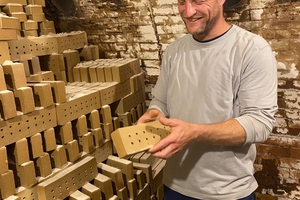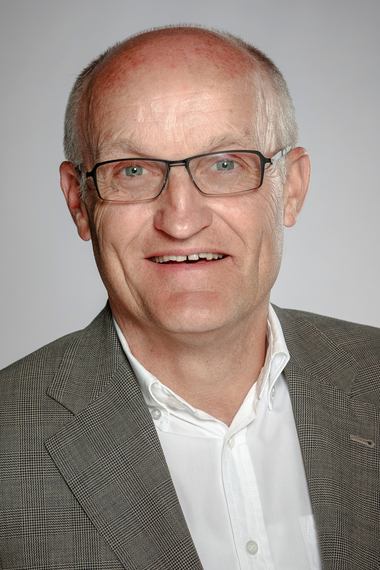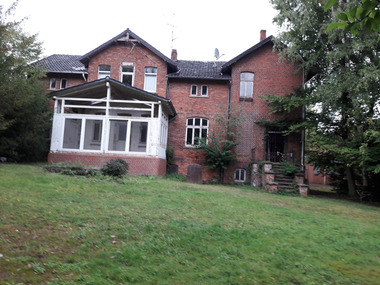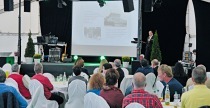A look inside the last Rhenish Hoffmann kiln at Gillrath Ziegel- u. Klinkerwerk
Anyone travelling by car on the A46 from the east to Gillrath Ziegel- u. Klinkerwerk GmbH & Co. KG. in Erkelenz must take care to stay in the right lane shortly before the Garzweiler open-cast lignite mine. Otherwise, the route inevitably leads onto the A44 and a ten-minute detour. This happens to every second visitor, explain the two managing directors Marcus and Bastian Gillrath to the ZI editorial team, who arrived late for their factory tour. In the following factory report, you can find out why proximity to open-cast mining can be worthwhile, how the family business is managing to weather the housing slump, how bricks from Erkelenz are making their way around the world, and what physiotherapy has to do with it.
Family business
The family business has been in existence for more than 150 years. Gillrath brick production was first mentioned in 1866. The Hoffmann kiln brickworks, which is still in operation today, was built in 1893. In 1994, Heinz Gillrath took over the management. Almost 20 years later, his sons joined the family business. Bastian Gillrath, a trained ceramic engineer, manages the factory, and Marcus Gillrath, a trained business economist, manages operations and marketing.
The factory
Old and new stand side by side on the factory premises. The oldest parts of the Hoffmann kiln are more than 130 years old, while the hall roof above it was rebuilt after a major fire in 2009. According to Bastian Gillrath, the company invests in the factory continuously and judiciously, within the scope of its possibilities. In 2014, a used water-struck press was purchased, the office building was constructed in 2018. The renovation of the chimney, which is severely corroded on the inside by the salt used in the kiln, is currently being planned. The top eleven metres are to be demolished and rebuilt with prefabricated elements. The chimney bricks are produced in-house and sent to a company to be set into prefabricated elements.
There are also many old machines that still run smoothly thanks to good maintenance and care. The managing directors place great importance on their employees handling these machines with the utmost care. They also emphasise the importance of keeping the factory clean. This was evident during the tour of the factory and the individual stations.
It was particularly impressive to watch the work in the Hoffmann kiln. The fire moves counterclockwise. At a temperature of 40 degrees Celsius, employees drive trolleys with blanks on metal sheets laid out on the sand floor into a kiln chamber, which is located on the side facing away from the fire in the direction of the fire. In three minutes, two workers precisely place a cartload of 120 dried bricks into the load. This is no trivial task, as the bricks are arranged in specific patterns to ensure stability, optimal air flow and vertical channels for coal discharge. The atmosphere is focused but cheerful, with jokes being told and laughter filling the air. At the same time, other employees remove the finished, cooled goods from the chamber on the right-hand side, behind the moving fire.
This is physically demanding work, with each setter handling several thousand bricks weighing almost three kilograms every day. Gillrath has a permanent team for this and takes care of their health and maintaining their working capacity. To this end, the company offers preventive and therapeutic measures such as physiotherapy and massage.
The stroll over the kiln is also interesting. Above each chamber, there are holes in the ceiling for inserting natural gas-fired burner lances, hoppers with a mixture of coal and sawdust, or lamps for loading and unloading into the chamber, depending on requirements and the work phase.
Current market situation
The brothers are satisfied with the business situation compared to market conditions in the industry. Demand is quite good and picking up again. Exports are somewhat more volatile. Driven by many high-quality projects abroad last year, they are declining slightly this year. However, this has been offset by other markets. Overall, exports to Australia, the USA, and Great Britain are an important mainstay.
Another important and currently stable pillar is project construction, especially public building construction and office projects. For example, an ongoing project in Hamburg is currently ensuring the basic utilisation of the plant.
In the residential segment, Marcus Gillrath reports that, after hitting a low point last year, the market for single-family homes has regained momentum, not only for upmarket properties but across the board.
Products and sales
When asked how Gillrath has managed to stay afloat even during the difficult phase since 2023, the managing directors point to the company’s very broad positioning in public building construction, renovation, projects and commercial buildings. Strategic sales decisions, sticking with Hoffmann kilns and market trends also play a role.
Renaissance of clinker
Marcus Gillrath explains that over the past ten years, they have benefited from a renaissance of clinker. At the beginning of the 2000s, plaster was still widely used, but that has changed significantly. Architects have also contributed to this with the development of new applications and an expansion of the desired colour palette.
Cooperation with Janinhoff
The successful international business is due in particular to a sales cooperation with Janinhoff Klinkermanufaktur in Münster that is unique in the industry. In 2009, Heinz Gillrath approached Hubert Foyer, managing director of Janinhoff, with the idea of a sales partnership, and he agreed. Since then, the two companies have been cooperating amicably and on an equal footing. The result is a strong sales network at home and abroad. Bastian Gillrath is particularly proud of a high-rise project in Manhattan, which they supplied together with Janinhoff.
Focus on project work
The focus on project work is also thanks to Heinz Gillrath. After the single-family home business, which had been very successful in the 1990s, declined sharply in the early 2000s, he focused on project work and collaboration with architects. In the beginning, coal-fired and traditionally manufactured clinker bricks were in demand for special projects. For the restoration of many sections of the Zollverein Coal Mine Industrial Complex, a World Heritage Site, for example, Gillrath produced clinker bricks that matched the old stock and complied with the requirements of monument protection. High-profile projects, such as the St. Nikolaus parish centre in Neuried, designed by Meck Architects and completed in 2008, helped the company establish itself in the project sector.
According to Bastian Gillrath, no one believed they could supply large-scale projects with clinker bricks of consistent material and colour quality. Precise series production is not easily done in a Hoffmann kiln. However, according to Marcus Gillrath, many projects in recent years prove that they can do it nonetheless. For the last major project for Wüstenroth Insurance, they supplied around 1.5 million clinker bricks over three years, 12,000 tonnes per year.
Products
Gillrath does not manufacture standard building ceramics, but premium products. The Hoffmann kiln firing gives the bricks a special feel and colour and small irregularities that make each brick unique. The use of coal, salt and other materials allows for a wide range of design options. Slight deformations are also possible by deliberately exceeding the sintering point. In addition, they can respond flexibly to deviating customer requirements. Finally, the Hoffmann kiln allows the production of authentic building materials for renovations in line with monument preservation guidelines.
Product innovations also play an important role. These include special formats, such as exclusive or very long bricks, such as a 49 cm long clinker brick. Ceramic shingles, which can be installed without mortar and are completely removable thanks to a suspension system, are also in high demand.
Green transformation
Starting points
At Gillrath, they are well aware of the urgent need to make their manufacturing processes climate-neutral. Marcus Gillrath explains that, in the worst case, the company could face additional costs of half a million euros in 2028 due to the CO2 price. Measures to improve energy efficiency and reduce emissions are therefore at the top of their list of priorities.
To make matters more difficult, climate-friendly solutions must be suitable for the company. In Gillrath’s case, this means maintaining the operation of the Hoffmann kiln and the use of coal. This is because the company’s success is largely based on the special bricks resulting from these instruments. Bastian Gillrath emphasises that they want to retain this feature, which is also tangible.
With an eye for detail and a sense of proportion
As a medium-sized family business, Marcus Gillrath emphasises that, in the end, it is always profitability that counts. Before making an investment decision, they therefore prefer to invest a little more in research.
The first step is to work more efficiently with the natural gas used to heat the kiln. According to Marcus Gillrath, the plan for the next few years is to control all processes outside the kiln as optimally as possible and, where possible, to electrify them. Gillrath is currently investing heavily in measurement and control technology in the drying chambers. In-depth studies are being conducted with the company Instalat on the use of heat pumps in combination with the utilisation of waste heat from the ring kiln. A CHP plant is already in place.
As far as the kiln is concerned, they are waiting for technical developments to see what will prove to be a viable option. Hydrogen as a substitute for natural gas has already been ruled out due to its low density. Electric heat generation is out of the question because of the resulting changes in product quality and colour.
A climate-neutral gas, such as synthetic or biogas, would be a possible alternative to natural gas, explains Marcus Gillrath. This is particularly true if it can be combined with subsequent CO2 capture. He is closely following research in this area. After all, captured CO2 or carbon could also be a usable by-product.
Coal
Coal poses a particular challenge. Compared to other active Hoffmann kilns in Germany, Gillrath uses the lowest proportion of coal. The addition corresponds to only five percent of the total fuel, with natural gas being the primary fuel. However, coal plays a very important role in colour effects and is difficult to replace, explains Bastian Gillrath. By using wood pellets, they can already save around 50 percent of coal.
Renewable energy
Measures to increase energy efficiency are being implemented continuously, with a target of eight percent per year. Energy management systems are also slowly coming into use. The existing PV systems are used partly for own consumption and partly for feed-in. The number of systems and the share of self-consumption are set to increase. The site already generates around half of the electricity it needs itself.
The Garzweiler open-cast mine is a wild card. The operator, RWE, is pursuing plans for PV and wind power plants there. It is possible that in a few years’ time, a major supplier of green electricity will be located right outside the factory gates.
Reuse
Another approach to increasing efficiency that is already proving successful is the reuse of clinker bricks. Gillrath works with a demolition company that provides demolition bricks for reuse in hybrid blends and broken bricks as aggregate for new bricks. This granulate replaces up to 50 percent of the primary raw materials in new bricks. This conserves the company’s own clay reserves and reduces the energy required for drying and firing. Bastian Gillrath reports on an experiment with 55 percent recycled material, which took the process to the extreme and produced bricks of clinker quality.
To ensure quality, a project was carried out with Professor Dr. Pascal Seffern at Koblenz University of Applied Sciences, and a bachelor’s student. The results provided insights into recipes and parameters, including the fact that a higher compressive strength can be achieved with a portion of mortar adhering to the demolition bricks.
Personnel
The Gillrath brothers are very satisfied with their team. Most of the employees have been with the company for many years and work reliably even under great pressure. In recent years, a middle management level has been introduced above the foremen to relieve the burden on the management. This has worked very well, and the business now runs independently of their presence.
Bastian Gillrath emphasises the exceptionally high level of communication in the factory. Due to the variety of products, they often have to discuss customer requirements, procedures and processes at length. The middle management level has proven its worth in this regard.
Filling vacant positions can be very difficult in some cases. Applicants can still be found for skilled positions such as locksmiths. It helps that Gillrath is a company that adheres to collective agreements and can score points with good pay, a family atmosphere and short decision-making processes, among other things. On the other hand, it is very difficult to find new staff for piecework with bricks in the Hoffman kiln under extreme heat. The job is semi-skilled, requires no training, only a willingness to do physical work, and is relatively well paid. However, there is no one on the open labour market who wants to carry bricks. Gillrath has been able to recruit several Ukrainians as employees. Through a programme run by the Federal Employment Agency, Georgians also work at the plant for several months of the year.










